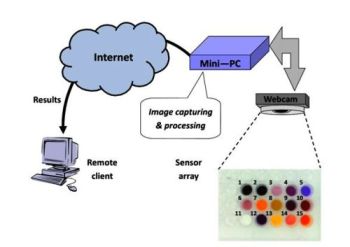Feb 11 2016
Researchers at UPM are developing a low-cost prototype that will allow us to remotely detect hazardous gases from the analysis of color changes adopted by certain compounds in the presence of such gases.
 Diagram of the prototype. / Montes-Robles (2015)
Diagram of the prototype. / Montes-Robles (2015)
This joint research between Universidad Politécnica de Valencia (UPV) and Universidad Politécnica de Madrid (UPM) has developed a sensor system that detects, through automatic image analysis, the color change produced in certain chemical compounds in presence of hazardous gases. The developed prototype can detect not only the presence of hazardous gases (CO, NO, NO2), but also to estimate its concentration in the atmosphere. This capacity to detect and estimate the gases concentration along with its low cost, makes this prototype a good candidate for industrial environments that need to control the harmful gases limits, according to the recommendations of the World Health Organization.
The detection of hazardous gases for health in industrial environments is a matter of great significance since there is a need to guarantee work safety. For this reason, over the last years many sensors of diverse technologies have been developed with this purpose. However, the progressive reduction of size and cost of digital photo cameras for the last decade, the growing geographic availability of Internet access as well as the miniaturization of computer equipment have enabled the design of alternative systems that involve a significant economic saving.
The three elements (digital cameras, internet access and mini computers) along with the selection of group of chemical compounds whose color changes in presence of certain gases in the atmosphere, are essential for the operation of the prototype designed by the team of Research Institute for Molecular Recognition and Technological Development (IDM) of UPM led by the Professors Ramón Martínez Máñez and Eduardo García Breijo in collaboration with the Professor Rubén Fraile Muñoz from School of Telecommunications Systems and Engineering at UPM.
The sensor system is mainly composed of a display with 13 compounds of variable color depending on the atmosphere. The changes of color of these compounds are detected through automatic image analysis taken by a mini computer equipped with a simple webcam. Finally, results are sent to a remote computer through Internet by using standard communication protocols.
The first trials carried out in order to assess the prototype allowed researchers to prove that this system works adequately detecting carbon monoxide (CO) and monoxide and nitrogen dioxide (NO, NO2) and even estimating the gas concentration in the atmosphere. This capacity to estimate gas concentration in the atmosphere is especially significant in certain industrial environments that require supervision to meet the limits recommended by the World Health Organization.
The usage of not very specific equipments (such as webcam and mini computers) and standard Internet communication protocols make viable not only the development of low cost detection system but also its potential integration in other control system of this industry. Besides, gas detection in the atmosphere from substances that change color also allows us the automatic and visual detection by an observer. Thus, the developed system becomes extensible to other fields such as the assessment of plastic-wrapped food through the detection of the presence of certain gases in their atmosphere.